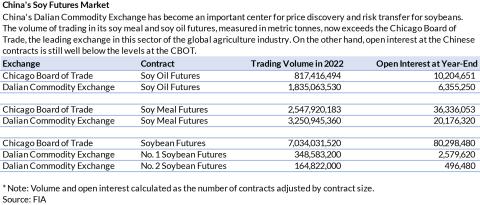China’s Zhengzhou Commodity Exchange opened futures and options in rapeseed oil, rapeseed meal and peanut kernel to overseas traders and intermediaries on 12 January, less than a month after the Dalian Commodity Exchange opened its entire soy complex to international trading.
China is the world's second-largest producer, importer and consumer of rapeseed oil, rapeseed meal, and the largest for peanuts. It is also the world's top consumer and the largest importer of soybeans.
The moves more than double the number of commodity futures and options contracts open to overseas traders and cap off a year that has seen China take significant steps to remove barriers to international participation. The list now covers 14 futures and nine options on futures based on a wide range of energy, metals, chemicals and agricultural commodities.
With the opening up of the latest contracts, the country is looking to further develop its exchanges as venues for international price discovery, with the aim of gaining greater influence over the pricing of the commodities it imports.
Price discovery
While relatively young compared to international markets, China’s futures markets have gradually become important centers for price discovery in a large number of globally traded commodities, including copper, cotton, sugar, palm oil and iron ore. Keeping an eye on price developments in Shanghai, Dalian and Zhengzhou is now standard business practice for commodity traders in other parts of the world.
Agricultural futures in particular rank among the world's most active. According to FIA’s 2021 annual futures and options volume survey, Chinese contracts occupied every spot in the world’s top 10 agricultural futures and options contracts by volume, and 15 of the top 20.
Dalian's move to open up its soy complex will be particularly interesting to overseas firms. The DCE offers futures and options on two varieties of soybeans as well as soy oil and soy meal. Its soy contracts are based on 10 metric tonnes of the underlying commodity, which means they are smaller in size than the soy contracts traded on the Chicago Board of Trade, the world leader in this sector of the global agricultural futures markets. But after adjusting for the size difference, the DCE soy meal and soy oil contracts outrank their counterparts on the CBOT in terms of volume. Open interest – which represents the number of outstanding contracts – is lower compared to the CBOT but still quite large.
Internationalization
China began to make its futures contracts available to the outside world in 2018, in an effort to strengthen its pricing power in the commodities markets it dominates.
The first was a yuan-denominated crude oil contract, launched in March 2018 on the Shanghai International Energy Exchange. This is now the world's third-largest crude oil futures contract, behind Brent and West Texas Intermediate.
Next China opened up its existing iron ore contract on the Dalian Commodity Exchange to foreign participants. Iron ore is a key ingredient in steel making and the contract is widely watched as an indicator for China's massive steel industry.
The other commodity futures contracts that have been opened to foreign participants include TSR 20 rubber, low-sulfur fuel oil, purified terephthalic acid, bonded copper and RBD palm olein.
The futures and options are yuan-denominated and settle through physical delivery. Foreign participants can use the yuan or the US dollar as margin, with write-off of profit, loss and delivery settlement in US dollar directly permitted.
QFI route
While internationalized contracts offer one way for foreign investors to participate in China derivatives trading, another route that gained traction in 2022 is the Qualified Foreign Investors (QFI) scheme. QFI was established in November 2020 to replace the Qualified Foreign Institutional Investor scheme and its yuan-denominated sibling RQFII. Those two schemes were established in 2002 and 2011 respectively, with the goal of making it easier for international investors to trade in China’s markets.
Under the new QFI rules, Chinese authorities relaxed the eligibility criteria to participate in its domestic markets and removed certain conditions, such as the minimum term of operation and size of assets under management. In effect, these changes mean a wider range of market participants can apply to become QFIs. As of August 2022, 711 foreign institutions had obtained QFI licenses.
The application process also was streamlined, electronic filing was enabled, and the new rules enabled QFIs to appoint multiple onshore custodians, as well as onshore futures brokers and exchange clearing members. Importantly, the rules expanded the number of futures and options in which a QFI can invest.
In September 2022, China's futures exchanges announced that QFIs would be able to trade in 27 commodity futures contracts and 18 commodity options contracts – the majority of which are not open to international investors.
Speaking at FIA’s Asia Derivatives Conference in December, Dr. Lawrence Zhang, rotating chief representative at the Joint Office of the Chinese Commodity Exchanges, gave a summary of the main differences between the two routes.
“Essentially, there are two ways to access China [future markets]. We have international products, which China started four and a half years ago with the crude oil contract. Investors can use US dollar as margin and then choose either US dollar or renminbi to get out. It's very simple. The second way started in September this year. QFI allows you to invest in 45 commodity futures and options products,” he explained.
He cautioned that firms using the QFI approach cannot make or take delivery of the underlying commodities. QFIs are not allowed to participate in the physical delivery process since they cannot receive and issue VAT invoices, which is the prerequisite of this kind of delivery.
“The route you take depends on what kind of client you are. If you are an industrialized client, if you choose the physical settle option, then you have to go through the international products. If you are a financial and only want to cash settle you go down the QFI route,” said Dr. Zhang.
New legal framework
Arguably the most significant milestone in 2022 for China’s derivatives markets, was the introduction of the Futures and Derivatives Law (FDL), which came into force on 1 August.
The FDL provides a legal and regulatory framework for the operation of the futures market in China covering a wide range of areas including trading, clearing, settlement and licensing. It also covers the supervision of all participants – exchanges, clearing houses, clearing members, and investors – as well as market misconduct, cross-border trading and overseas futures in which Chinese investors invest.
Importantly, it enshrines in law the enforceability of close-out netting, removing a significant barrier to the development of the futures market with the aim of paving the way to greater international participation and more effective risk management.
Speaking at the FIA Asia conference, Sharon Shi, chief executive of derivatives clearing firm G.H. Financials, described the FDL as the “most important milestone in the history of China futures market development.”
Shi said that when China’s futures products began to be accessible to international investors in 2018, many were cautious about entering the market.
A big hurdle was trust and predictability. China’s commodity exchanges are closely tied to the state and authorities in the past have intervened readily in markets. China’s intervention in equity markets after a downturn in 2015, for instance, led to a ban on short-selling and investors with big stakes in companies were not allowed to sell shares.
“There was a certain layer of concern because there was no regulatory or legislative framework that governed the China futures market. Some international clients were concerned, for example, by the lack of transparency, consistency and predictability of the policy-making process,” Shi said. “The FDL is an important milestone in this respect.”
Marcus Goi, managing director and chief executive of Orient Futures International in Singapore, agreed with Shi, saying that the FDL delivers a strong legal foundation and provides protection for investors going into China. His firm was established in 2018 by Orient Securities, an investment bank and brokerage firm headquartered in Shanghai.
“This is important for overseas traders, which have stayed out of the Chinese market for the longest time,” he said. However, Goi pointed to some of the challenges international investors face in deciphering some of the Chinese rules.
“The China market is different, so for many international participants who are keen to trade in the Chinese market, you need to understand all the trading rules, the clearing rules, and what the dos and don'ts are,” Goi said. “Don't assume that because we are all trading in the futures market, the trading rules are similar. I don't disagree that trading rules are quite similar globally, but in particular to China, there are certain rules that are pretty unique. When foreign participants go into the Chinese market, they need to take note of all the trading rules.”
Incremental steps
China’s approach to opening up the country’s futures markets has been gradual and incremental, according to long-time observers. This incremental approach is best depicted in a metaphor attributed to Deng Xiaoping, the country’s former leader, as “crossing the river by feeling the stones under the feet”.
“[Chinese regulators] are never going to bang their doors wide open on this front. Certainly, some of the feedback about opening up the markets, and explicitly derivatives, is that they need to prove to the general public and the population in China that this is actually good for the economy,” Simon Walker, managing director and head of APAC equity risk at Morgan Stanley, said during the FIA Asia conference.
“There are views that [opening up] creates more volatility. During downturns, derivatives are linked to that, so it will take time for them to convince the broader community in China. The way that we've witnessed QFI open up is how we will continue to see other aspects of the market and other financial products offered on derivatives exchanges [for international investors] being launched. It will be in small pockets. It's a good strategy because if you do it incorrectly and you need to pull everything back, it will set things back by years,” Walker said.
However more can and should be done, according to Zhang. For China to encourage the interest of more overseas investors to participate, it needs to continue to enrich its international product pool, he said.
“We need to list more products. Right now, there are about 100 products in China, and we only have a few internationalized products and the QFI 45. We need to have more, given the size of the Chinese economy,” he said. “It takes time, but we will get there.”



